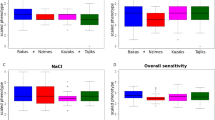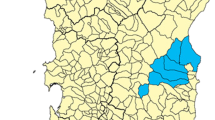Abstract
BECAUSE of the high correspondence between bitterness and the toxicity of naturally occurring bitter products1, it is important for many free-ranging animals to be able to recognize and reject bitter tasting stimuli. The wild rat and mouse have also been subjected to synthetic rodenticides, many of which are bitter tasting2. Selection pressures would therefore be expected to be directed toward maintaining sensitivity to bitter stimuli. By the same reasoning, sensitivity to bitter stimuli might well have been lost in some of the highly inbred strains of laboratory mice. Evidence of individual differences in responsiveness in non-homogeneous strains is suggestive of this trend3.
This is a preview of subscription content, access via your institution
Access options
Subscribe to this journal
Receive 51 print issues and online access
$199.00 per year
only $3.90 per issue
Buy this article
- Purchase on Springer Link
- Instant access to full article PDF
Prices may be subject to local taxes which are calculated during checkout
Similar content being viewed by others
References
Richter, C. P., J. Comp. Physiol. Psychol., 43, 358 (1950).
Moncrieff, R. W., The Chemical Senses (Leonard Hill Bks., London, 3rd ed., 1967).
Warren, R. P., Science, 140, 808 (1963).
Cox, G., Ferguson, J., and Dodds, M., Indust. Eng. Chem., 25, 967 (1933).
Green, M., Bull. Nat. Formul. Comm., 10, 131 (1942).
Krizenecky, J., Z. Untersuch. Lebensm., 81, 21 (1941).
Linegar, C., Bull. Nat. Formul. Comm., 11, 59 (1943).
Warren, R. P., and Pfaffmann, C., J. Comp. Physiol. Psychol., 52, 263 (1959).
Warren, R. P., and Vince, M. A., J. Comp. Physiol. Psychol., 56, 910 (1963).
Brindley, L. D., Animal Behaviour, 13, 507 (1965).
Hartmann, G., Ann. Eugen., 9, 123 (1939).
Jacobs, B. B., J. Hered., 53, 183 (1962).
Goedde, H. W., and Ohligmacher, H., Humangenetik, 1, 423 (1965).
Dawson, W., West, G. B., and Kalmus, H., Ann. Hum. Genet., 30, 273 (1967).
Ford, E. B., Genetic Polymorphism (Faber and Faber, London, 1965).
Author information
Authors and Affiliations
Rights and permissions
About this article
Cite this article
WARREN, R., LEWIS, R. Taste Polymorphism in Mice involving a Bitter Sugar Derivative. Nature 227, 77–78 (1970). https://doi.org/10.1038/227077a0
Received:
Issue Date:
DOI: https://doi.org/10.1038/227077a0
This article is cited by
-
Behavioral genetics and taste
BMC Neuroscience (2007)
-
Inbred mouse strains C57BL/6J and DBA/2J vary in sensitivity to a subset of bitter stimuli
BMC Genetics (2005)
-
C3.SW-SOA a heterozygous congenic taster mice
Behavior Genetics (1995)
-
Chromosome mapping ofSoa, a gene influencing gustatory sensitivity to sucrose octaacetate in mice
Behavior Genetics (1992)
-
The B6.SW bilineal congenic sucrose octaacetate (SOA)-Taster mice
Behavior Genetics (1989)
Comments
By submitting a comment you agree to abide by our Terms and Community Guidelines. If you find something abusive or that does not comply with our terms or guidelines please flag it as inappropriate.



